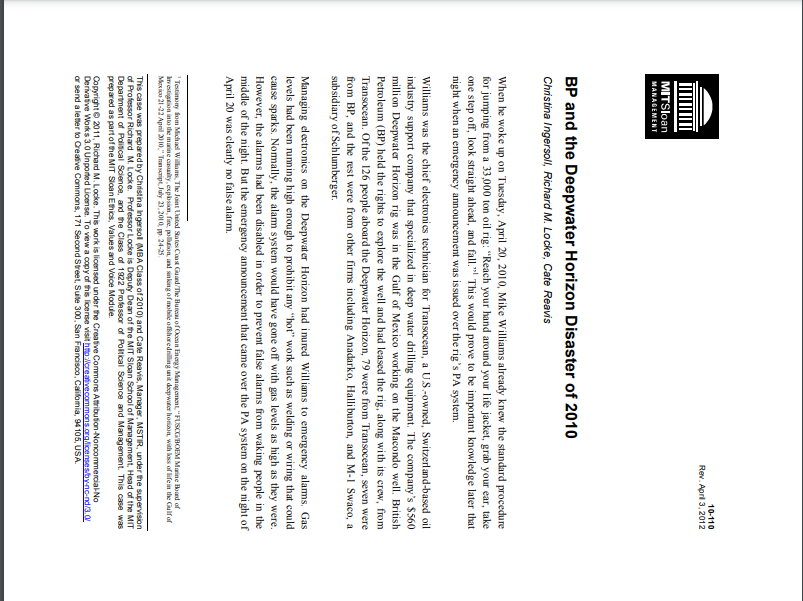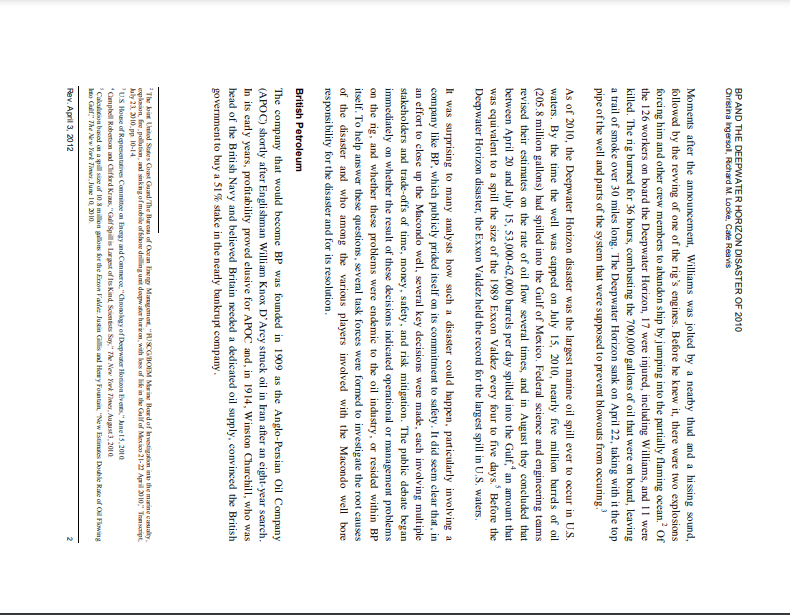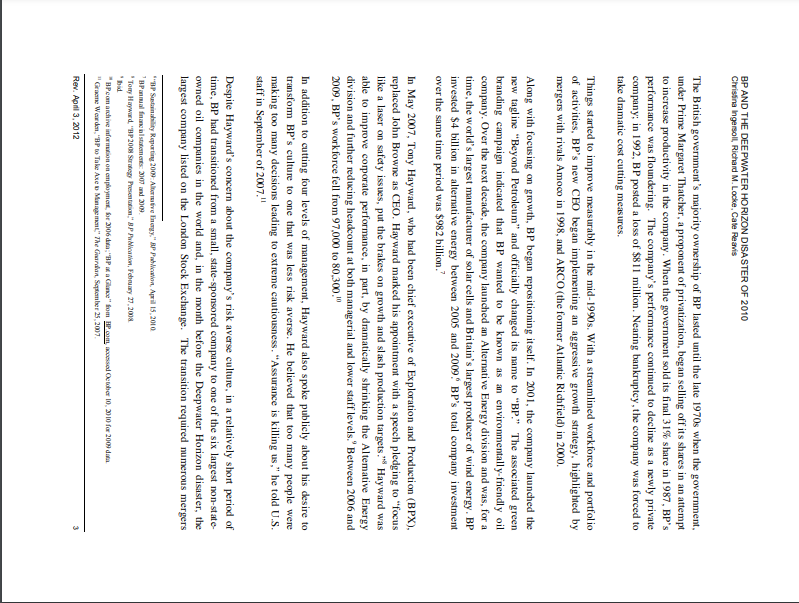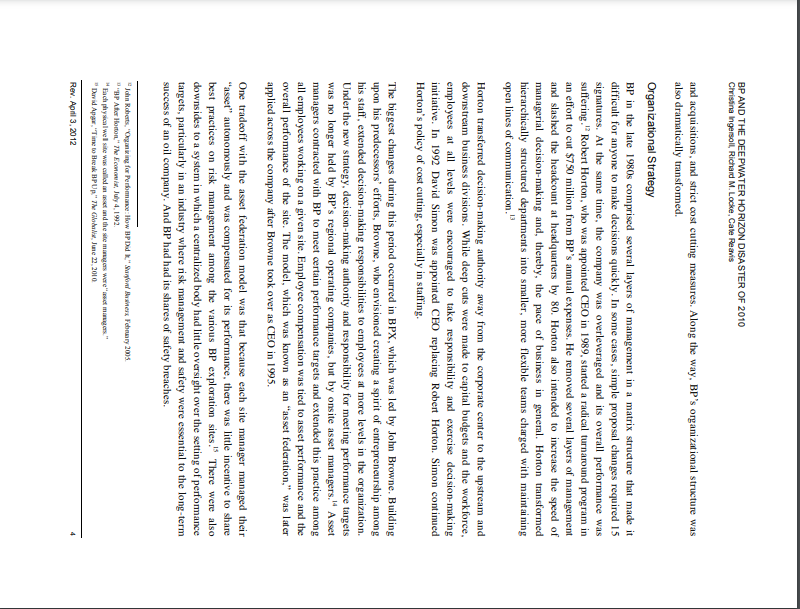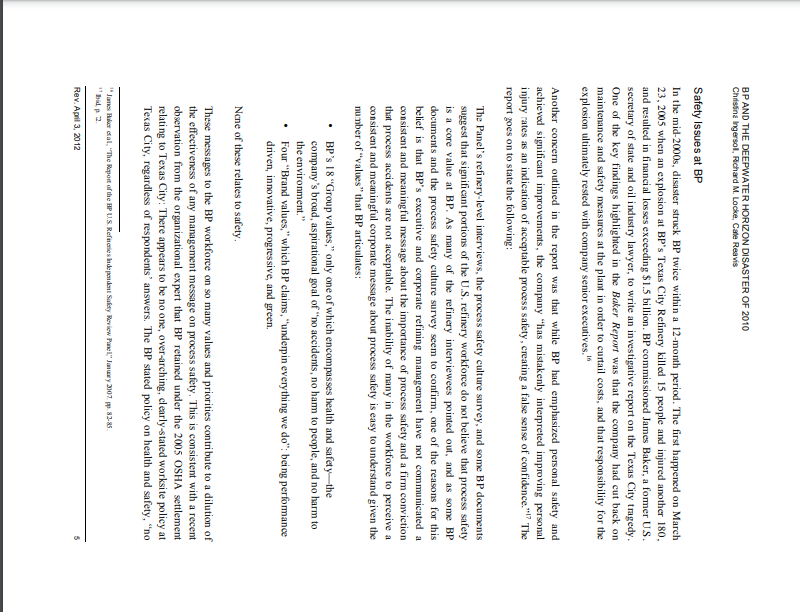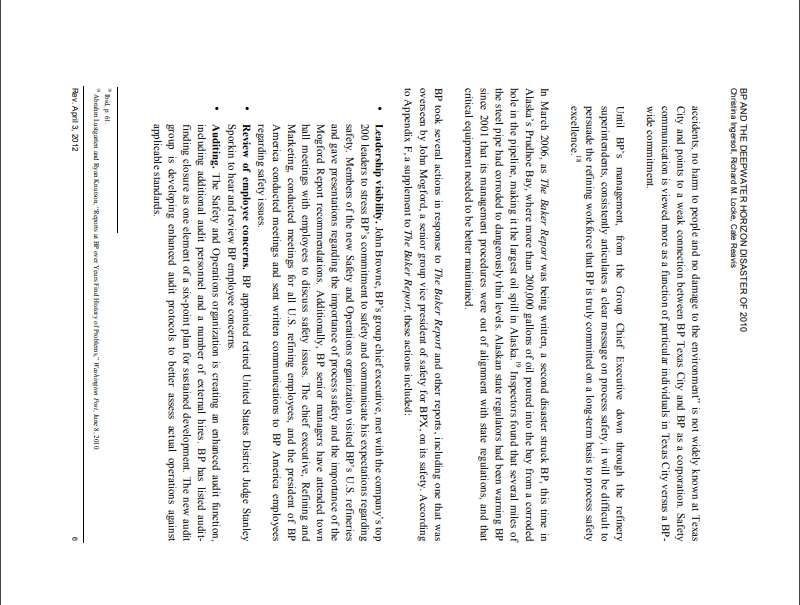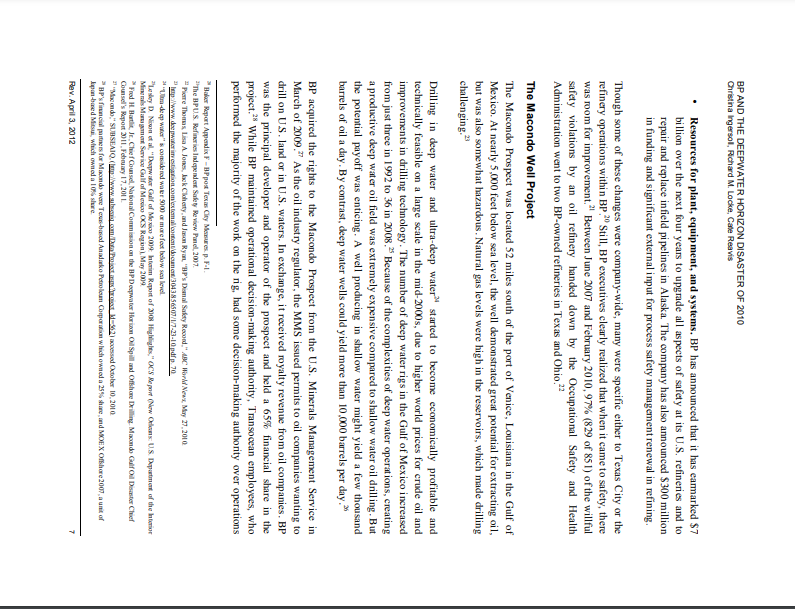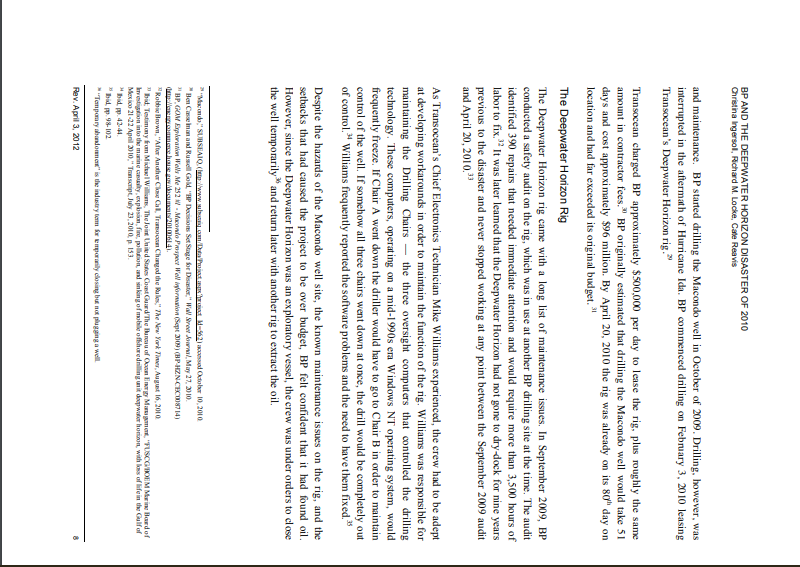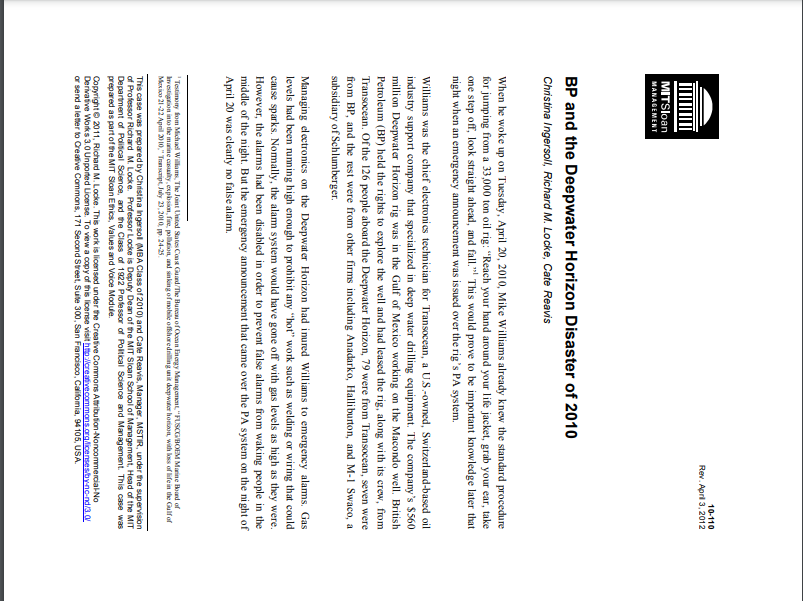
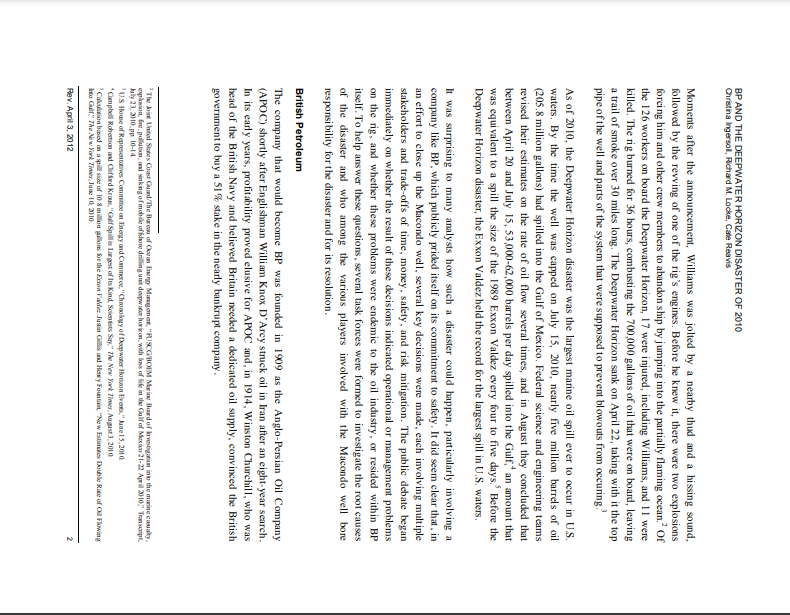
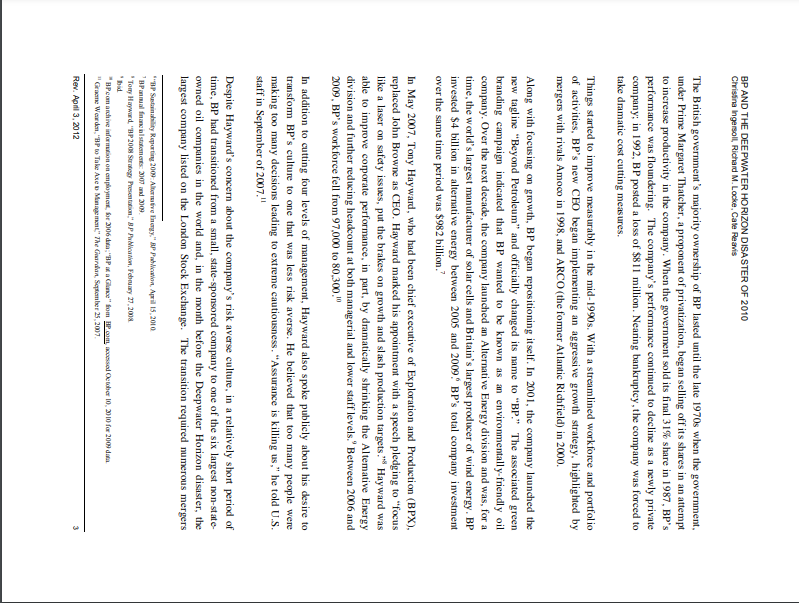
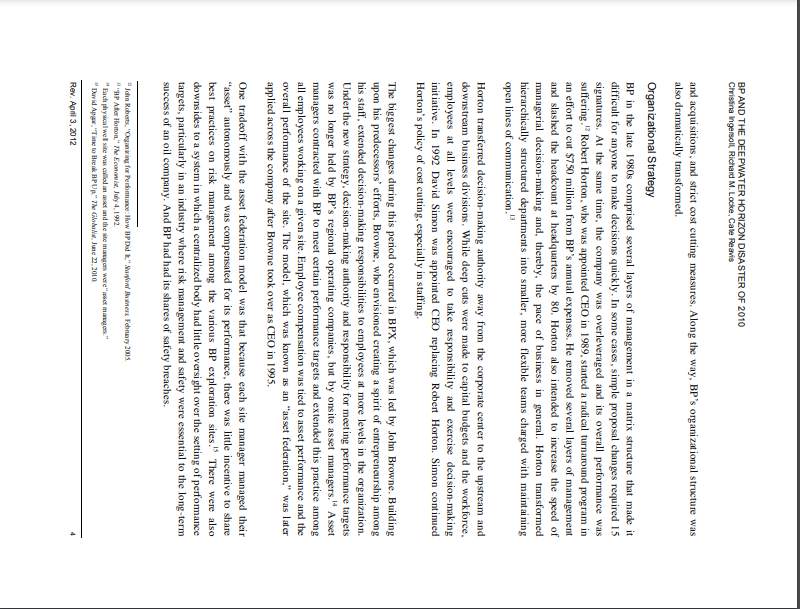
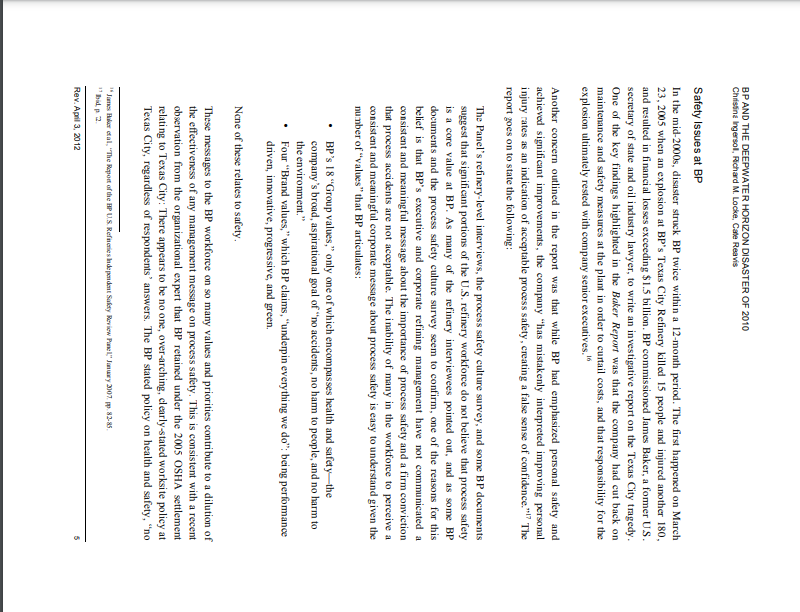

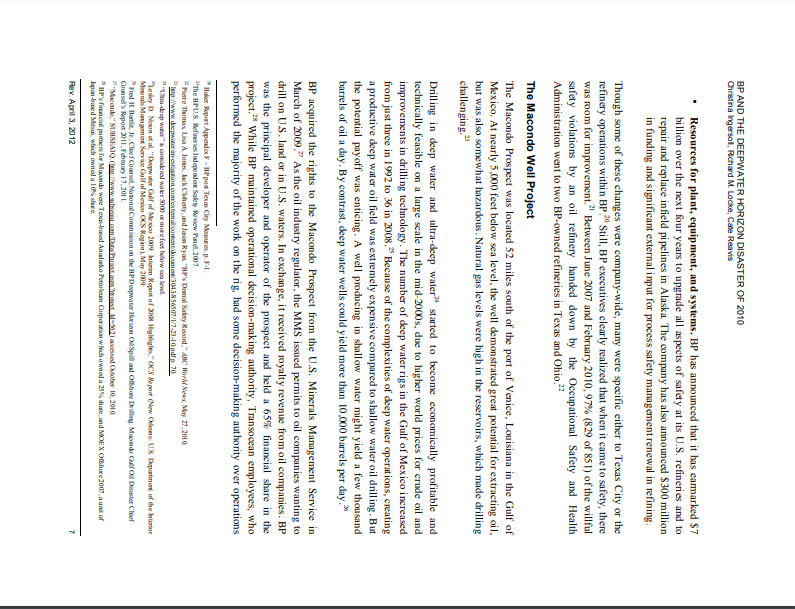
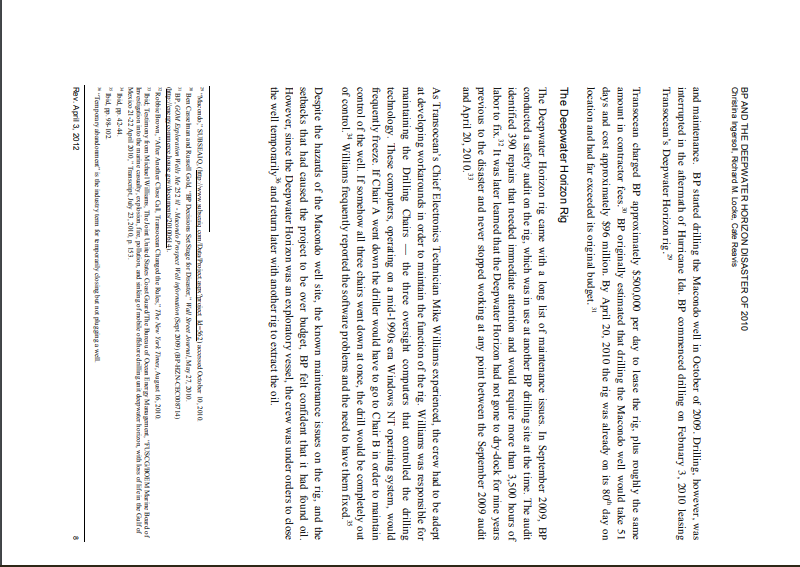
Describe theBP and theDeepwaterHorizon Disaster of 2010case study and the leading issues in this case using the information presented in the case description. (I have the REMAINING pages pertaining to the other pages to the same question) thank you
10-110 Rev . April 3, 2012 MITSloan MANAGEMENT BP and the Deepwater Horizon Disaster of 2010 Christina Ingersoll, Richard M. Locke, Cate Reavis When he woke up on Tuesday, April 20, 2010, Mike Williams already knew the standard procedure for jumping from a 33,000 ton oil rig: "Reach your hand around your life jacket, grab your ear, take one step off, look straight ahead, and fall." This would prove to be important knowledge later that night when an emergency announcement was issued over the rig's PA system. Williams was the chief electronics technician for Transocean, a US-owned, Switzerland-based oil industry support company that specialized in deep water drilling equipment. The company's $560 million Deepwater Horizon rig was in the Gulf of Mexico working on the Macondo well. British Petroleum (BP) held the rights to explore the well and had leased the rig, along with its crew, from Transocean. Of the 126 people aboard the Deepwater Horizon, 79 were from Transocean, seven were from BP, and the rest were from other firms including Anadarko, Halliburton, and M-I Swaco, a subsidiary of Schlumberger. Managing electronics on the Deepwater Horizon had inured Williams to emergency alarms, Gas levels had been running high enough to prohibit any "hot" work such as welding or wiring that could cause sparks. Normally, the alam system would have gone off with gas levels as high as they were. However, the alarms had been disabled in order to prevent false alarms from waking people in the middle of the night. But the emergency announcement that came over the PA system on the night of April 20 was clearly no false alarm. Testimony from Michael Wiliams, The Joint United Sate Coast Guard/The Bureau of Ocean Energy Managenat, "FUSCGBOEM Marine Board of Investigation into the marine crankty, explosion, fire, pollution, and sinking of mobile ofshoredrilling unit deepwater horizon, with loss of lifein the Gulf of Mexico 21-22 April 2010," Transcript July 13,2010. pp. 24-35. This case was prepared by Chilstina Ingersol (MBA Class of 2010) and Cate Reavis, Manager, MSTIR, under the supervision of Professor Richard M. Locke. Professor Locke is Deputy Dean of the MIT Sloan School of Management, Head of the MIT Department of Political Science, and the Class of 1922 Professor of Political Science and Management. This case was prepared as part of the MIT Sloan Ethics, Values and Voice Module. Copyright @ 2011, Richard M. Locke. This work is licensed under the Creative Commons Attribution-Noncommercial-No Derivative Works 3.0 Unported License. To view a copy of this license visit http Ware rive commons org licenses by-no-ndo.( or send a letter to Creative Commons, 171 Second Street, Suite 300, San Francisco, Califomia, 94 105, USA.BP AND THE DEEPWATER HORIZON DISASTER OF 2010 Christina Ingersoll, Richard M. Locke, Cate Reavis Moments after the announcement, Williams was jolted by a nearby thud and a hissing sound, followed by the revving of one of the rig's engines. Before he knew it, there were two explosions forcing him and other crew members to abandon ship by jumping into the partially flaming ocean.' Of the 126 workers on board the Deepwater Horizon, 17 were injured, including Williams, and 1 1 were killed. The rig burned for 36 hours, combusting the 700,000 gallons of oil that were on board, leaving a trail of smoke over 30 miles long. The Deepwater Horizon sank on April 22, taking with it the top pipe of the well and parts of the system that were supposed to prevent blowouts from occuring." As of 2010, the Deepwater Horizon disaster was the largest marine oil spill ever to occur in U.S. waters. By the time the well was capped on July 15, 2010, nearly five million barrels of oil (205.8 million gallons) had spilled into the Gulf of Mexico. Federal science and engineering teams revised their estimates on the rate of oil flow several times, and in August they concluded that between April 20 and July 15, 53,000-62,000 barrels per day spilled into the Gulf,* an amount that was equivalent to a spill the size of the 1989 Exxon Valdez every four to five days.' Before the Deepwater Horizon disaster, the Exxon Valdez held the record for the largest spill in U.S. waters. It was surprising to many analysts how such a disaster could happen, particularly involving a company like BP, which publicly prided itself on its commitment to safety. It did seem clear that , in an effort to close up the Macondo well, several key decisions were made, each involving multiple stakeholders and trade-offs of time, money, safety, and risk mitigation. The public debate began immediately on whether the result of these decisions indicated operational or management problems on the rig, and whether these problems were endemic to the oil industry, or resided within BP itself. To help answer these questions, several task forces were formed to investigate the root causes of the disaster and who among the various players involved with the Macondo well bore responsibility for the disaster and for its resolution. British Petroleum The company that would become BP was founded in 1909 as the Anglo-Persian Oil Company (APOC) shortly after Englishman William Knox D'Arcy struck oil in Iran after an eight-year search. In its early years, profitability proved elusive for APOC and, in 1914, Winston Churchill, who was head of the British Navy and believed Britain needed a dedicated oil supply, convinced the British government to buy a 51% stake in the nearly bankrupt company . The bird United States Chat Quand/The Bureau of Cem Bury Mayeat. "FX GOP Mazing Bord of hustization inb the marine caually, Jiy 23. 2010.pp 10-14 wakeion fry pollution, and sinking of mobile offshore drilling unit deepwater horizon, with bes of life in the Gulf of Mexico 21-22 April 2010" Transcript 'U.S House of Reposentatives Canmince on Energy and Canmarce "Chronology of Depwater Horbon Events, " June 15,2010 Campbell Robertson and Clifford Krave, "Gulf Spill is Largest of Its Kind Scientists Say" The New York Ther, August 3,2010 "Calculation based on a spill size of 10.8 millon gallons be the Erma Valdez Justin Gillis and Hary Fountain, "New Estimates Double Rate of Of Flowing Into Gulf" The New York /moves, June 10. 2010. Rev. April 3, 20 12BP AND THE DEEPWATER HORIZON DISASTER OF 2010 Christina Ingersoll, Richard M. Locke, Cate Reavis The British government's majority ownership of BP lasted until the late 1970s when the government. under Prime Margaret Thatcher, a proponent of privatization, began selling off its shares in an attempt to increase productivity in the company. When the government sold its final 31% share in 1987, BP's performance was floundering. The company's performance continued to decline as a newly private company; in 1992, BP posted a loss of $811 million. Nearing bankruptcy, the company was forced to take dramatic cost cutting measures. Things started to improve measurably in the mid-1990s. With a streamlined workforce and portfolio of activities, BP's new CEO began implementing an aggressive growth strategy, highlighted by mergers with rivals Amoco in 1998, and ARCO (the former Atlantic Richfield) in 2000. Along with focusing on growth, BP began repositioning itself. In 2001, the company launched the new tagline "Beyond Petroleum" and officially changed its name to "BP." The associated green branding campaign indicated that BP wanted to be known as an environmentally friendly oil company. Over the next decade, the company launched an Alternative Energy division and was, for a time, the world's largest manufacturer of solar cells and Britain's largest producer of wind energy. BP invested $4 billion in alternative energy between 2005 and 2009." BP's total company investment over the same time period was $982 billion.? In May 2007, Tony Hayward, who had been chief executive of Exploration and Production (BPX). replaced John Browne as CEO. Hayward marked his appointment with a speech pledging to "focus like a laser on safety issues, put the brakes on growth and slash production targets." Hayward was able to improve corporate performance, in part, by dramatically shrinking the Altemative Energy division and further reducing headcount at both managerial and lower staff levels." Between 2006 and 2009. BP's workforce fell from 97,000 to 80.300." In addition to cutting four levels of management, Hayward also spoke publicly about his desire to transform BP's culture to one that was less risk averse. He believed that too many people were making too many decisions leading to extreme cautiousness. "Assurance is killing us," he told U.S. staff in September of 2007." Despite Hayward's concern about the company's risk averse culture, in a relatively short period of time, BP had transitioned from a small, state-sponsored company to one of the six largest non-state- owned oil companies in the world and, in the month before the Deepwater Horizon disaster, the largest company listed on the London Stock Exchange. The transition required numerous mergers tarinability Reporting 20(03 Alternative Energy." AP Publication, April 15,2010 "HP annual Inand in I statements: 2007 and 2104. Tony Hayward "HP2001 Strategy Presentation," BP Publication, February 27,2008. bid "APcon archive information on employment, for 2106 don; "HP at a Glance" from HP. com accessed October 10, 21 10 for 2009 dam. "Grace Warden, "HP to Take Axe D Management" The Guardian, Squanber 25, 2017. Rev. April 3, 2012BP AND THE DEEPWATER HORIZON DISASTER OF 2010 Christina Ingersoll, Richard M. Locke, Cate Reavis and acquisitions, and strict cost cutting measures. Along the way. BP's organizational structure was also dramatically transformed. Organizational Strategy BP in the late 1980s comprised several layers of management in a matrix structure that made it difficult for anyone to make decisions quickly. In some cases, simple proposal changes required 15 signatures. At the same time, the company was overleveraged and its overall performance was suffering." Robert Horton, who was appointed CEO in 1989, started a radical turnaround program in an effort to cut $750 million from BP's annual expenses. He removed several layers of management and slashed the headcount at headquarters by 80. Horton also intended to increase the speed of managerial decision-making and, thereby, the pace of business in general. Horton transformed hierarchically structured departments into smaller, more flexible teams charged with maintaining open lines of communication. " Horton transferred decision-making authority away from the corporate center to the upstream and downstream business divisions. While deep cuts were made to capital budgets and the workforce. employees at all levels were encouraged to take responsibility and exercise decision-making initiative. In 1992 David Simon was appointed CEO replacing Robert Horton. Simon continued Horton's policy of cost cutting, especially in staffing. The biggest changes during this period occurred in BPX, which was led by John Browne. Building upon his predecessors' efforts, Browne, who envisioned creating a spirit of entrepreneurship among his staff, extended decision-making responsibilities to employees at more levels in the organization. Under the new strategy, decision-making authority and responsibility for meeting performance targets was no longer held by BP's regional operating companies, but by onsite asset managers." Asset managers contracted with BP to meet certain performance targets and extended this practice among all employees working on a given site. Employee compensation was tied to asset performance and the overall performance of the site. The model, which was known as an "asset federation," was later applied across the company after Browne took over as CEO in 1995. One tradeoff with the asset federation model was that because each site manager managed their "asset" autonomously and was compensated for its performance, there was little incentive to share best practices on risk management among the various BP exploration sites." There were also downsides to a system in which a centralized body had little oversight over the setting of performance targets, particularly in an industry where risk management and safety were essential to the long-term success of an oil company. And BP had had its shares of safety breaches. " John Roberts, "Orgmaking for Perbanakce:How BPDid It." Saxonr Bumhers Febamry 2015 ""HP After Horton," The Econouts, July 4, 1992. " Each physical well site was caled on asset and the site managers were"ascl minges" " David Aper, "Time to Break BP Up" The Globally, June 22, 2010 Rev. April 3. 20 12BP AND THE DEEPWATER HORIZON DISASTER OF 2010 Christina Ingersoll, Richard M. Locke, Cale Reavis Safety Issues at BP In the mid-2000s, disaster struck BP twice within a 12-month period. The first happened on March 23, 2005 when an explosion at BP's Texas City Refinery killed 15 people and injured another 180. and resulted in financial losses exceeding $1.5 billion. BP commissioned James Baker, a former US. secretary of state and oil industry lawyer, to write an investigative report on the Texas City tragedy. One of the key findings highlighted in the Baker Report was that the company had cut back on maintenance and safety measures at the plant in order to curtail costs, and that responsibility for the explosion ultimately rested with company senior executives," Another concern outlined in the report was that while BP had emphasized personal safety and achieved significant improvements, the company "has mistakenly interpreted improving personal injury rates as an indication of acceptable process safety, creating a false sense of confidence." The report goes on to state the following: The Panel's refinery-level interviews, the process safety culture survey, and some BP documents suggest that significant portions of the U.S. refinery workforce do not believe that process safety is a core value at BP. As many of the refinery interviewees pointed out, and as some BP documents and the process safety culture survey seem to confirm, one of the reasons for this belief is that BP's executive and corporate refining management have not communicated a consistent and meaningful message about the importance of process safety and a firm conviction that process accidents are not acceptable. The inability of many in the workforce to perceive a consistent and meaningful corporate message about process safety is easy to understand given the number of "values" that BP articulates; . BP's 18 "Group values," only one of which encompasses health and safety-the company's broad, aspirational goal of "no accidents, no harm to people, and no harm to the environment." . Four "Brand values," which BP claims, "underpin everything we do": being performance driven, innovative, progressive, and green. None of these relates to safety. These messages to the BP workforce on so many values and priorities contribute to a dilution of the effectiveness of any management message on process safety. This is consistent with a recent observation from the organizational expert that BP retained under the 2005 OSHA settlement relating to Texas City: There appears to be no one, over-arching, clearly-stated worksite policy at Texas City, regardless of respondents' answers. The BP stated policy on health and safety, "no "Jokes Aide cal, "The Report of the HP (.S. Refineries Independent Safety Review Panel" Imuzy 2107. pp. 82-85. "bid p 2. Rev. April 3, 20 12BP AND THE DEEPWATER HORIZON DISASTER OF 2010 Christina Ingersoll, Richard M. Locke, Cate Reavis accidents, no harm to people and no damage to the environment" is not widely known at Texas City and points to a weak connection between BP Texas City and BP as a corporation. Safety communication is viewed more as a function of particular individuals in Texas City versus a BP- wide commitment. Until BP's management, from the Group Chief Executive down through the refinery superintendents, consistently articulates a clear message on process safety, it will be difficult to persuade the refining workforce that BP is truly committed on a long-term basis to process safety excellence. 18 In March 2006, as The Baker Report was being written, a second disaster struck BP, this time in Alaska's Prudhoe Bay, where more than 200,000 gallons of oil poured into the bay from a corroded hole in the pipeline, making it the largest oil spill in Alaska." Inspectors found that several miles of the steel pipe had corroded to dangerously thin levels. Alaskan state regulators had been warning BP since 2001 that its management procedures were out of alignment with state regulations, and that critical equipment needed to be better maintained. BP took several actions in response to The Baker Report and other reports, including one that was overseen by John Mogford, a senior group vice president of safety for BPX, on its safety. According to Appendix F. a supplement to The Baker Report, these actions included; Leadership visibility. John Browne, BP's group chief executive, met with the company's top 200 leaders to stress BP's commitment to safety and communicate his expectations regarding safety. Members of the new Safety and Operations organization visited BP's U.S. refineries and gave presentations regarding the importance of process safety and the importance of the Mogford Report recommendations. Additionally, BP senior managers have attended town hall meetings with employees to discuss safety issues. The chief executive, Refining and Marketing, conducted meetings for all U.S. refining employees, and the president of BP America conducted meetings and sent written communications to BP America employees regarding safety issues. Review of employee concerns. BP appointed retired United States District Judge Stanley Sporkin to hear and review BP employee concerns. Auditing. The Safety and Operations organization is creating an enhanced audit function, including additional audit personnel and a number of external hires. BP has listed audit- finding closure as one element of a six-point plan for sustained development. The new audit group is developing enhanced audit protocols to better assess actual operations against applicable standards. " bid p ol. " Abrahm Lustgarten and Ryan Knutson. "Reports of HP over Year Find Hisbay of Problems" Washington Post, June 3, 2010. Rev. April 3, 2012BP AND THE DEEPWATER HORIZON DISASTER OF 2010 Chrislina Ingersol, Richard M. Locke, Cale Reavis . Resources for plant, equipment, and systems. BP has announced that it has earmarked $7 billion over the next four years to upgrade all aspects of safety at its U.S. refineries and to repair and replace infield pipelines in Alaska. The company has also announced $300 million in funding and significant external input for process safety management renewal in refining. Though some of these changes were company-wide, many were specific either to Texas City or the refinery operations within BP .2 Still, BP executives clearly realized that when it came to safety, there was mom for improvement." Between June 2007 and February 2010, 97% (829 of 851) of the willful safety violations by an oil refinery handed down by the Occupational Safety and Health Administration went to two BP-owned refineries in Texas and Ohio.?2 The Macondo Well Project The Macondo Prospect was located 52 miles south of the port of Venice, Louisiana in the Gulf of Mexico. At nearly 5,000 feet below sea level, the well demonstrated great potential for extracting oil, but was also somewhat hazardous. Natural gas levels were high in the reservoirs, which made drilling challenging. 3 Drilling in deep water and ultra-deep water" started to become economically profitable and technically feasible on a large scale in the mid-2000s, due to higher world prices for crude oil and improvements in drilling technology. The number of deep water rigs in the Gulf of Mexico increased from just three in 1992 to 36 in 2008." Because of the complexities of deep water operations, creating a productive deep water oil field was extremely expensive compared to shallow water oil drilling. But the potential payoff was enticing. A well producing in shallow water might yield a few thousand barrels of oil a day . By contrast, deep water wells could yield more than 10,000 barrels per day . BP acquired the rights to the Macondo Prospect from the U.S. Minerals Management Service in March of 2009." As the oil industry regulator, the MMS issued permits to oil companies wanting to drill on US. land or in U.S. waters. In exchange, it received royalty revenue from oil companies, BP was the principal developer and operator of the prospect and held a 65% financial share in the project." While BP maintained operational decision-making authority, Transocean employees, who performed the majority of the work on the rig, had some decision-making authority over operations "Baker Report Appendix F - HPpost Texas Chy Mesures p. F-1. "The BPUS. Refineries Independent Saley Review Panel, 2017. "Pierre Thomas, Lisa A Jones, back Cloherty, and Jawn Ryan, "HP's Dianal Safety Record," ABC Marks News, May 27.2010 " hup Wwww.deepwaterim Jcomten Ddo con c/3043856507/1/7-23-10 pdf p. 70 34"Worn -deep water" Is considered wake 9100 a more fed below sea level "Lady D Nia dad. "Degeeter Gulf of Mexico 2014 harim Repod of 2108 Highlights." OCS Report (New Orleans U.S. Department of the Interior Ming rats Mangement Service Gulf of Mexico CX'S Region ) May 2004 " Fred H. Batit, Jc, Chief Counsel, National Commission on the BP Deepwater Harian Oil Spill and Ofthore Drilling Macaids Gulf Oil Disaster Chief Counsel's Report 2011, February 17,201 1. as lucio Me562) accessed October 10.2010 "BP's finned panes for Moondo were Teen-based Anadarko Perolam Corporation which owned a 25% share, and MOEX Offhore 2007,a unit of pan-bored Misui, which owned a 10. shre Rev. April 3, 2012BP AND THE DEEPWATER HORIZON DISASTER OF 2010 Christina Ingersoll, Richard M. Locke, Cate Reavis and maintenance. BP started drilling the Macondo well in October of 2009. Drilling, however, was interrupted in the aftermath of Hurricane Ida. BP commenced drilling on February 3. 2010 leasing Transocean's Deepwater Horizon rig." Transocean charged BP approximately $500.000 per day to lease the rig, plus roughly the same amount in contractor fees." BP originally estimated that drilling the Macondo well would take 51 days and cost approximately $96 million. By April 20, 2010 the rig was already on its 80 day on location and had far exceeded its original budget. " The Deepwater Horizon Rig The Deepwater Horizon rig came with a long list of maintenance issues. In September 2009, BP conducted a safety audit on the rig, which was in use at another BP drilling site at the time. The audit identified 390 repairs that needed immediate attention and would require more than 3,500 hours of labor to fix." It was later learned that the Deepwater Horizon had not gone to dry-dock for nine years previous to the disaster and never stopped working at any point between the September 2009 audit and April 20, 2010,33 As Transocean's Chief Electronics Technician Mike Williams experienced, the crew had to be adept at developing workarounds in order to maintain the function of the rig. Williams was responsible for maintaining the Drilling Chairs - the three oversight computers that controlled the drilling technology. These computers, operating on a mid-1990s era Windows NT operating system, would frequently freeze. If Chair A went down the driller would have to go to Chair B in order to maintain control of the well. If somehow all three chairs went down at once, the drill would be completely out of control." Williams frequently reported the software problems and the need to have them fixed." Despite the hazards of the Macondo well site, the known maintenance issues on the rig, and the setbacks that had caused the project to be over budget, BP felt confident that it had found oil. However, since the Deepwater Horizon was an exploratory vessel, the crew was under orders to close the well temporarily* and return later with another rig to extract the oil. "Bon Case inan and Ruse Gold "HP Decisions Sat Stage bor Disata," Wall Breed Juvenal, May 27, 2010. "BP GOM Exploration Wells Me 252 My . Macanda Prospect Well Maraswan (Sept 2109) (HP HEN CECOS7 14) "Rothis Brown, "After Another Chey Cal, Tracyown Changed the Pukes" The New York Theer, August 16,2010 "bid Testimony fon Michel Wilms, The Joint Univd States Coast Guard The Brau of Coan Energy Manipumet. 'FUSCOTOEM Mring Hard of Investigation into the mazing causedty, explosion, fir, pollution, and sinking of mobile offshoredriling init doopwater horizon, with bes of life in the Gulf of Mexico 21 -22 April 20 10 " Transcript July 23 2010. A. 153. " bid PP. 42-44. bid pp. 98- 102 ""Temporary abandoned" is the industry tem bo emporiily closing but no plugging a well Ray. April 3, 20 12








